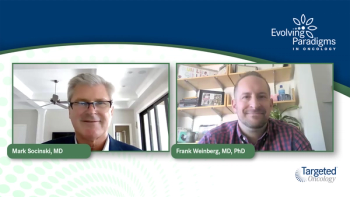
Treatment Considerations for Second-Line Therapy in Follicular Lymphoma
A hematologist/oncologist provides insights on individualizing second-line therapy for patients with relapsed/refractory follicular lymphoma.
Episodes in this series

Perry Cook, MD: What should we offer patients in second-line therapy? I think we’ve discussed at length the opportunities for patients who are early progressors. They should receive something very different than what they received before. On the other hand, last week I saw a patient who had a 10-year response to rituximab and bendamustine. He now has palpable axillary nodes, and his imaging shows minimal disease elsewhere. I’m going to watch him, and when his disease progression justifies additional therapy, I’m very likely to return to chemoimmunotherapy, because he did so well the first time. I think his chances of doing half as well the second time are reasonably good, so I would go back to the previous therapy, unlike the plan for the patient who progressed 19 months into therapy that we talked about before. The late progressors have all the options on the table, and the experience they’ve had before is likely to be predictive of the experience that they’ll have with retreatment.
In follicular lymphoma, the EZH2 status is quite predictive of response. Both EZH2 mutated and unmutated patients respond to tazemetostat. The duration of response is longer in the unmutated patients, but the overall response rate is twice as high in the mutated patients. Other molecular features that are predictive of response are shared with other B-cell malignancies, so patients with 17p or TP53 mutations or ATM mutations are more likely to have an aggressive clinical course. But those markers are not as wildly used in follicular lymphoma as, say, in chronic lymphocyte leukemia.
How would I treat this patient who progresses 19 months into therapy? I would be very much influenced by his access to medical care. If he was located at a profound distance and was hard to follow, and had access to a local laboratory, I would consider radioisotopes as one of his options. If he is EZH2 unmutated, as this patient was, certainly tazemetostat is an attractive option, because it is not very burdensome to the patient. The response rate is 35%, which is very competitive with any of the other options he has, and the median duration of response is 13 months, which is likewise competitive. I would consider tazemetostat if I knew his EZH2 status or could find it out. How else could he be treated? If he lives in my neighborhood, and it’s no burden for him to come to the office, then IMiD [immunomodulatory imide drug] therapy with a CD20 drug; if he received rituximab with bendamustine, then I would be more likely to give him obinutuzumab with lenalidomide as an option. And that would be someone who lived close by and could come for weekly obinutuzumab during the first month, and then a monthly obinutuzumab, and could check his blood counts frequently. This would be a significantly more burdensome therapy, in my view, which requires closer evaluation and more frequent clinic visits, than with tazemetostat. And so, for a 79-year-old that lives at a distance, tazemetostat would certainly be an attractive option and something I would consider.
This transcript has been edited for clarity.
Case: A 76-Year-Old Man With Relapsed/Refractory Follicular Lymphoma
Initial presentation
- A 76-year-old man complains of a 4-month history of bloating, fevers, and unintended weight loss of 9 lbs
- PMH: Medically-controlled hypertension, brittle diabetes, CABG 10 years prior
- SH: Lives by himself 2.5 hours from the clinic; only daughter lives out of state
- PE: palpable right axillary lymph nodes, ~ 3 cm and bilateral cervical lymph nodes, ~ 2 cm; spleen palpable 4.5 cm below left costal margin
Clinical workup
- Labs: ANC 1.6 x 109/L, WBC 11.4 x 109/L, 45% lymphocytes, Hb 9.5 g/dL, plt 96 x 109/L, LDH 426 U/L, B2M 3.4 µg/mL; HBV negative
- GFR 59 ml/min
- Excisional biopsy of the axillary lymph node on IHC showed CD 20+, CD 3+, CD5+, CD 10+, BCL2+; follicular lymphoma grade 2
- Bone marrow biopsy showed paratrabecular lymphoid aggregates, 42% involvement
- Cytogenetics: t(14;18) (q32;q21)
- Molecular testing: EZH2 wild type
- PET/CT showed right axillary, bilateral cervical, and mediastinal lymphadenopathy (3.3 cm, 3.4, cm and 2.6 cm, and 3.2 respectively)
- Ann Arbor Stage IV; ECOG 1
Treatment
- He was treated with bendamustine and rituximab for 6 cycles, achieved complete response and continued on rituximab maintenance
- Side effects included grade 3 diarrhea with BR
- 16 months later he complained of fevers and chills with increasing frequency
- Repeat PET/CT revealed progression of disease
- He received R-CHOP for 6 cycles and continued on rituximab maintenance
- 11 months later he had worsening fatigue and increased weight loss and work up revealed progressive disease
- He was started on tazemetostat 800 mg BID








































